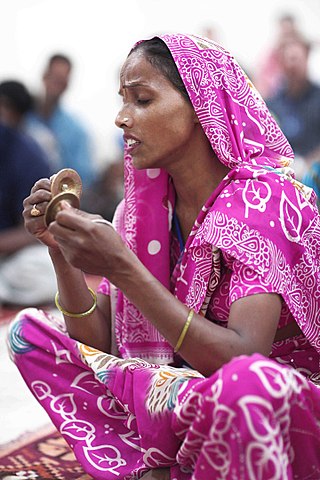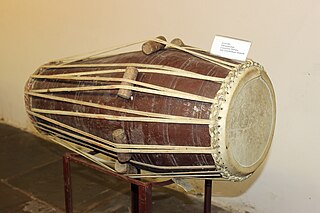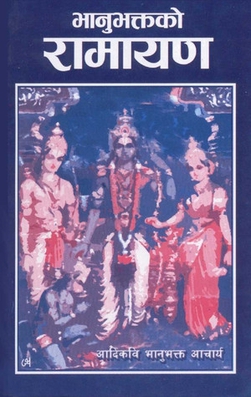Madhya laya or Madhyalaya is a medium tempo of a rhythm in Indian classical music. [1] [2]
Medium tempo, a speed between 80 and 160 mātrās per minute. While Madhya laya is sometimes confused with Vilambit and vice versa, it is about two beats per second. According to some scholars like Subhajit Mandal, Madhya laya is visible in three phase:
Madhya + Vilambit, Madhya + Madhya, Madhya + Drut.
It could be said that what is characterized as Chhanda in first felt in Madhya tempo. Chhanda can be defined as generations of a definite, repetitive line of recognizable duration that bestows a definite length on the concerned tonal phase.
Madhya + Vilamvit = Known as ‘Dagur ki badhat’ consists of embellishments and chikari works.
Madhaya + Madhya = Also known as ‘Madhya Jod’ or ‘Barabar ki jod’ abundantly consists of musical embellishment known as ‘Gamaka’. In ‘tata’ instruments, fretwork is on the increase in the phase.
Madhya + Drut= The phase is also known as ‘Ladi ki jod’. It has a faster tempo than the Madhaya + Madhya.
Taals used in madhya laya include Jhaptal, Teental, Tilwada, Rupak and Keherwa.
Khyal or Khayal is a major form of Hindustani classical music in the Indian subcontinent. Its name comes from a Persian/Arabic word meaning "imagination". Khyal is associated with romantic poetry, and allows the performer greater freedom of expression than dhrupad. In khyal, ragas are extensively ornamented, and the style calls for more technical virtuosity.
Hindustani classical music is the classical music of the Indian subcontinent's northern regions. It may also be called North Indian classical music or, in Hindustani, shastriya sangeet. The term shastriya sangeet literally means classical music, and is also used to refer to Indian classical music in general. It is played on instruments like the veena, sitar and sarod. Its origins from the 12th century CE, when it diverged from Carnatic music, the classical tradition in South India. While Carnatic music largely uses compositions written in Sanskrit, Kannada, Telugu, Tamil, Malayalam, Hindustani music largely uses compositions written in Hindi-Urdu, Braj, Avadhi, Punjabi, and Rajasthani,.

A tala literally means a 'clap, tapping one's hand on one's arm, a musical measure'. It is the term used in Indian classical music similar to musical meter, that is any rhythmic beat or strike that measures musical time. The measure is typically established by hand clapping, waving, touching fingers on thigh or the other hand, verbally, striking of small cymbals, or a percussion instrument in the Indian subcontinental traditions. Along with raga which forms the fabric of a melodic structure, the tala forms the life cycle and thereby constitutes one of the two foundational elements of Indian music.

Pandit Kumar Gandharva, originally known as Shivaputra Siddharamayya Komkalimath was an Indian classical singer, well known for his unique vocal style and for his refusal to be bound by the tradition of any gharana. The name, Kumar Gandharva, is a title given to him when he was a child prodigy; a Gandharva is a musical spirit in Hindu mythology.

Ustad Amir Khan was one of the greatest and most influential Indian vocalists in the Hindustani classical tradition. He was the founder of the Indore gharana.

The pakhavaj is a barrel-shaped, two-headed drum, originating from the Indian subcontinent, the oldest version of double sided drums and its descendants are mridangam of Southern India and kendang of Maritime Southeast Asia and other South Asian double-headed drums. Its older forms were made with clay.
Irama is the term used for tempo in Indonesian gamelan in Java and Bali. It can be used with elaborating instruments. It is a concept used in Javanese gamelan music, describing melodic tempo and relationships in density between the balungan, elaborating instruments, and gong structure. It is distinct from tempo, as each Irama can be played in different tempi. Irama thus combines "the rate of temporal flow and temporal density"; and the temporal density is the primary factor.

Aashish Khan Debsharma is an Indian classical musician, a player of the sarod. He was nominated for a Grammy Award in 2006 for the 'Best Traditional World Music Album' category for his album "Golden Strings of the Sarode". He is also a recipient of the Sangeet Natak Akademi Award. Besides being a performer, composer, and conductor, he is also an adjunct professor of Indian classical music at the California Institute of the Arts, and the University of California at Santa Cruz, in the United States.
Drut is the concluding section, in fast tempo, between 160 and 320 beats per minute, of the performance of a vocal raga in Hindustani classical music.
Vilambit is an introductory slow tempo, or laya, between 10 and 40 beats per minute, used in the performance of a raga in Hindustani classical music. For major ragas, the vilambit portion generally takes up two-thirds or more of the performance, and is followed by a short drut to conclude the performance. Vocalists use a slower definition of time than instrumentalists. Vilambit is a part of 3 different kinds of Layas, all of them have different speeds and can be referred to later on.
Wahid Khan was an Indian surbahar and sitar player. He was the son of Imdad Khan and belonged to the Imdadkhani gharana or Etawah gharana of classical music.
Adana is an Indian raag. It is also called Adana Kanada. It is often sung or played in drut laya after a vilambit composition in raga Darbari Kanada, as Adana is straighter than Darbari in its chalan, thus allowing faster passages. The flow of this raga is similar to a mix of Madhumad Sarang / Megh and Darbari. Another common vivadi some artists use sparingly is shuddha nishad which enhances the Saranga mood of the raga.

Carnatic music terms are briefly described in this page. Major terms have their own separate article pages, while minor terms are defined / described here.
Gandharva Mahavidyalaya New Delhi is an institution established in 1939 to popularize Indian classical music and dance. The Mahavidyalaya (school) came into being to perpetuate the memory of Pandit Vishnu Digambar Paluskar, the great reviver of Hindustani classical music, and to keep up the ideals set down by him. The first Gandharva Mahavidyalaya was established by him on 5 May 1901 at Lahore. The New Delhi school follows the syllabi set by the Akhil Bharatiya Gandharva Mahavidyalaya Mandal.
Pandit Balwant Rai Bhatt was a noted Indian composer and musician of Hindustani Vocal Music. He was also known as Bhavrang (भावरंग). He died at his home in Varanasi on 2 May 2016.

A tabla is a pair of hand drums from the Indian subcontinent. Since the 18th century, it has been the principal percussion instrument in Hindustani classical music, where it may be played solo, as an accompaniment with other instruments and vocals, or as a part of larger ensembles. It is frequently played in popular and folk music performances in India, Bangladesh, Afghanistan, Pakistan, Nepal and Sri Lanka. The tabla is an essential instrument in the bhakti devotional traditions of Hinduism and Sikhism, such as during bhajan and kirtan singing. It is one of the main qawwali instruments used by Sufi musicians. The instrument is also featured in dance performances such as Kathak. Tabla is a rhythmic instrument.
Indore gharana is one of the vocal gharanas of Indian classical music. It was founded by Amir Khan, who studied the styles of Abdul Wahid Khan, Aman Ali Khan, Rajab Ali Khan and Abdul Karim Khan and amalgamated their style.
Bandish, cheez or gat is a fixed, melodic composition in Hindustani vocal or instrumental music. It is set in a specific raga, performed with rhythmic accompaniment by a tabla or pakhawaj, a steady drone, and melodic accompaniment by a sarangi, violin or harmonium. There are different ways of systematizing the parts of a composition. A bandish provides the literature element in the music, for standard structured singing. In the past many gharanas protected their bandishes from moving out of the family with gross incoherent vocal renditions. In the realm of vocal music, it is often known as cheez.

Ragini Trivedi is an Indian classical musician performing on vichitra veena, sitar and jal tarang. Daughter of the vichitra veena player and musicologist Lalmani Misra, she is an exponent of Misrabani and is the creator of a digital music notation system called Ome Swarlipi.

Bhanubhakta Ramayana, commonly known as Ramayan, is the Nepali translation of Valmiki Ramayana by Adikavi Bhanubhakta Acharya. It was posthumously published in its complete form in 1887. It is widely considered to be the first Nepali epic. The prose style of the epic has been termed Bhanubhaktiya Laya since it was completely original in Nepali literature, being the first work. Due to this distinction, the author, poet Bhanubhakta Acharya is known as Adikavi in Nepal.
3. Music Context: A Concise Dictionary of Hindusthani Music - Ashoke Damodar Ranade